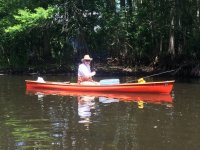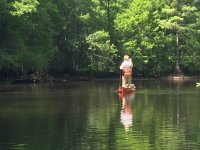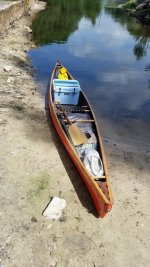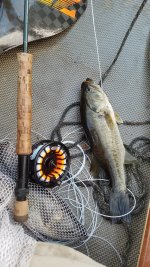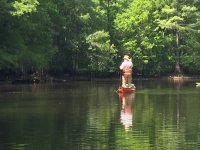billconnor said:
After 20 years of tripping in Q and BWCA in canoes designed for that water, I'm trying to learn what would be better for Adirondacks.
I simply want to continue long excursions, but in this part of the country.
I'm not trying to be a contrarian, but I don't know what the significant difference is among these water venues. If you skip the whitewater in the Adirondacks, it's 90+% lake paddling just like BWCA. There are connecting streams, but the extremely serpentine examples such as the Oswegatchie and north branch of the Moose are not typical. I'd use the same canoe for extended tripping on all these lake waters and connecting streams -- my Hemlock SRT or, if I were under 180 lbs., my Bell Wildfire.
I know I wanted a lightweight canoe at age 35, even more so at 45, even more so at 55, even more so at 65, and even more so at 75. There seems to be a natural pattern there, and perhaps you sense the same one. Therefore, stick with a canoe under 40 pounds.
I also sense you want sufficient capacity for comfort and freeboard and that you may not be a small pack canoe guy, which are harder to get into and out of, by the way, especially for older folks with weak legs and knees.
I'm going to boil down your actual objective to this statement:
billconnor said:
The Q17 and Tranq are nearly flat bottom and near no rocker, and don't turn sharply for me . . . . Maybe I should have followed my first impulse and gotten the [Swift] Prospector [15] and not looked further.
Aside from the fact that flat bottoms don't necessarily affect turnability, rocker does. The
Swift Propector 15 is a fine canoe I'm sure, but it has the same advertised rocker of 1" as your 15-5
Souris Tranquility and is a lot wider. The
Swift Prospector 16 is a different story; it has 2" of rocker and is actually narrower than the Prospector 15, but still wider than your Tranquility.
I haven't paddled a Tranquility but if you want a boat of similar capacity but easier turnability, you might want to take a trip to Hemlock, NY, and look at Dave Curtis's
15-9 Peregrine and 14-9 Kestrel. They are sittable if you put the seat low enough, and the height is easy to adjust with shims and wing nuts.
As for Swift, the Keewaydin 15 and 16 may be more turnable than the Prospector 15 and are likely faster because narrower. Swifts may be hard to come by, however, because the border is closed due to Covid. North Star has a lot of lightweight solo offerings now, some with 1.5" to 2.5" of rocker -- Phoenix, Northwind Solo, Trillium -- but I've never seen them in person. There are also older Bells and Swifts that are good turners if you can find them, such as the Bell Merlin II and Swift Osprey.
Good luck in your search. I still recommend learning to heel that Tranquility more aggressively for turns. Here is a recent two-part article on the subject with pictures and links to demonstrative videos of paddling in the extremely twisty NJ Pine Barrens, by fellow northern New Yorker and Adirondack paddler Marc Ornstein:
A Pitch For Heeling, Part 1
A Pitch for Heeling, Part 2
From the articles, here's a good paddler sharply turning a flattish bottom canoe with an aggressive heel.



